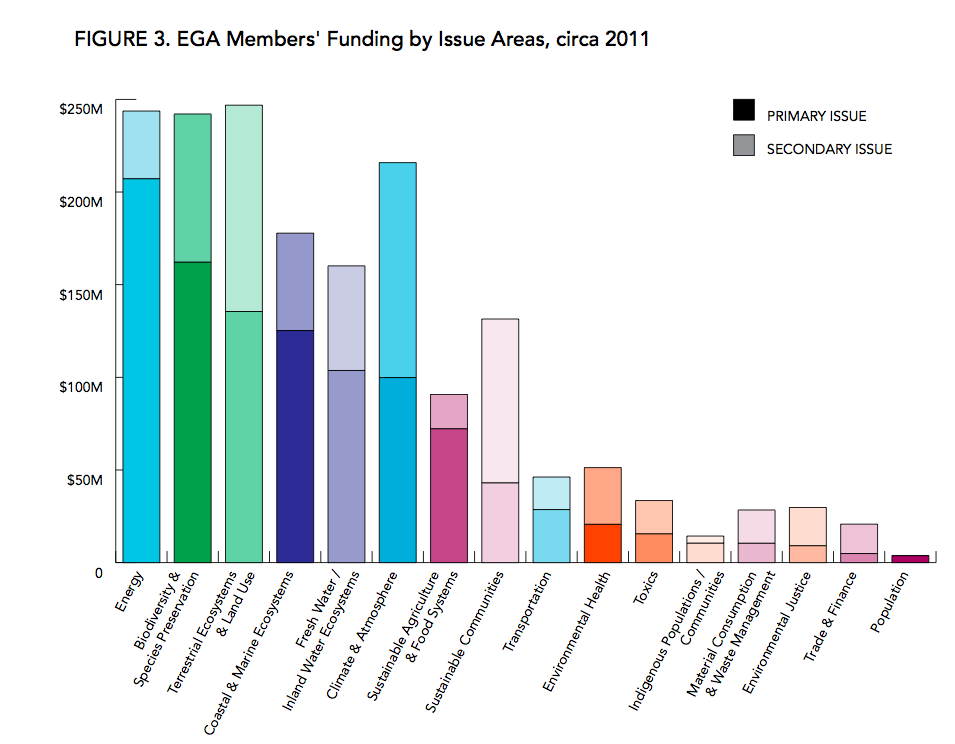This blog post was authored by Franny Chiles Canfield, Senior Manager of Program and Knowledge at the Environmental Grantmakers Association.
Finding opportunities to discuss, share and collaborate on grantmaking strategies with other funders goes a long way in ensuring portfolios remain effective and relevant. But funder gatherings are not the only way to learn from other grantmakers that are interested in combating the same issues. Do funders’ approaches differ depending on the issues they tackle? Where is funding being focused – or leaving gaps?
The Environmental Grantmakers Association (EGA) has made it a priority to answer these questions through our Tracking the Field project. This project includes a semi-annual report, a searchable Tracking the Field database, and an interactive trending grant heat map. Tracking the Field Volume 4: Analyzing Trends in Environmental Philanthropy was published in September 2013. The new EGA report analyzes over 40,000 grants by approximately 200 EGA member foundations from 2007-2011, as well a birds-eye analysis of environmental philanthropy with data provided by the Foundation Center.
Our report uncovers many interesting connections and key correlations between strategies, geographic regions and issue area concentrations. In 2011, estimated funding to environmental issues by all U.S. foundations reached an all-time high of $2.8 billion. In the same year, the total environmental giving by EGA Members equaled $1.13 billion (40% of all environmental giving). Environmental giving by EGA members dropped 17% in 2009 but experienced gains of 28% and 2% in 2010 and 2011. As the following graph illustrates, environmental philanthropy spans many issues.
EGA Members’ Funding by Issue Areas, circa 2011

Because Health and Justice grants (“Environmental Heath”, “Toxics”, and “Environmental Justice”) are so crosscutting, it is especially important to consider all grants that identify Health and Justice issues as primary or secondary issue areas. When using these metrics, we find that $100 million (9%) of EGA members’ grants in 2011 were targeted at Health and Justice issues. EGA and HEFN staff, comparing membership lists, noted that the EGA database includes just over half of HEFN members’ grants.
Where are Health and Justice Grants Geographically Focused?
EGA members’ Health and Justice grants are largely given to organizations that focus domestically. There are proportionally far fewer grant dollars going to Health and Justice abroad than members’ other environmental philanthropic giving. Only 12% of Health and Justice grant dollars went outside of North America compared to 23% overall.
Our members’ Health and Justice funding is also more local than environmental funding overall. This is demonstrated by far less “Federal Level” and cross-regional funding for Health and Justice issues. Only 21% percent of domestic funding went to the “Federal Level” compared to 27% overall.
So Where are Environmental Health and Justice Grants Going?
The Health and Justice funders we track fund the Pacific Coast and Southeast more than overall environmental grantmaking. Twenty-four percent of domestic funding goes to the Pacific Coast compared to 19% for all environmental issue areas. Eighteen percent of domestic funding to Health and Justices went to the Southeast compared to 11% overall.
What are the Strategies Behind These Grants?
“Advocacy / Organizing / Movement Building” is the most common strategy behind EGA members’ grantmaking, but it is especially common within Health and Justice grantmaking. Fifty-three percent of Health and Justice grants used the strategy “Advocacy / Organizing / Movement Building” compared to 30% of all environmental funding. This correlates with the more local focus of “Advocacy / Organizing / Movement Building” grants.
Within EGA members’ environmental funding overall, only 1% of grants were for litigation as the primary strategy. However, we found that 25% of “Environmental Justice” grants used litigation as the primary strategy behind the grant.
How Does Tracking the Field Connect us?
With over 40,000 grants tagged, Tracking the Field allows foundations to not only make strategic decisions based on data – it also helps find colleagues in the field. With the complexity of environmental issues, it is key that funders are aware of their colleagues’ related grants. All foundations, regardless of size or type, can learn valuable lessons from each other’s giving. Check out the Summary of Tracking the Field to learn more about the landscape and where you can have the greatest impact.

Franny Chiles Canfield is the Senior Manager of Program and Knowledge at the Environmental Grantmakers Association (EGA). Starting at EGA in 2008, she served as the Research and Data Coordinator for Tracking the Field Volume 2 and the Author and Tracking the Field Project Manager for Tracking the Field Volume 3 and 4. She was the Project Manager for EGA’s new website, searchable Tracking the Field database, and the interactive Tracking the Field heat map.
